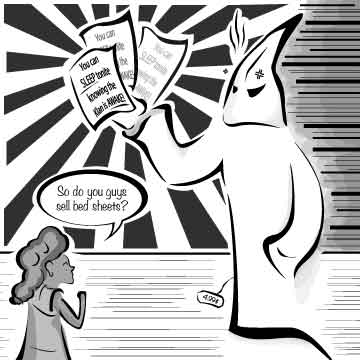Free speech and the scourge of hate groups
April 6, 2015
“You can sleep tonight knowing the Klan is awake!”
The image of a klansman above the words “Neighborhood Watch,” stares out from dark slits in a white hood. Above the white peak of his organizational costume are the words “Traditionalist American Knights of the Ku Klux Klan.”
To many, these words and images seem like they belong in a history book. Perhaps the dramatic opening to a documentary about Reconstruction or the Civil Rights Movement. Instead, these words were printed on fliers found in a Spokane Valley neighborhood late this February, not even a month and a half ago.
Than late in February, hate crime touched a member of the Eastern family, impacting a professor and many students. In an email, Black Student Union President Satori Butler said,
“My adviser Rachel Doležal has experience[d] a horrific amount of hate mail, threaten letters, and vandalism to her vehicle. Witnessing this happened to a person that I have a professional relationship with generates a number of emotions: Anger, worry, fear to name a few … So on [behalf] of the entire Black Student Union at EWU witnessing what Rachel Doležal was and is still currently experiencing as [NAACP] president has had a major impact on our organization.”
The Klan is not an artifact of the past — although it may be soon. Klan membership has been dropping steadily since 2004, weakened by competing organizations with less bad press. Still, given the violent and terroristic history of the Klan, many people, including myself, wonder why the Klan, and other hate groups—like the one that targeted Doležal—are permitted to exist at all in the United States at all.
The answers to these questions turn on the definitions of “hate group” and “permit.”
According to the FBI’s “Hate Crime Data Collection Guidelines And Training Manual,” published on Feb. 27 of this year, a hate group is “an organization whose primary purpose is to promote animosity, hostility and malice against persons of or with a race, religion, disability, sexual orientation, ethnicity, gender or gender identity which differs from that of the members or the organization.”
The Southern Poverty Law Center uses a similar, albeit looser, definition, saying, “hate groups have beliefs or practices that attack or malign an entire class of people, typically for their immutable characteristics.”
By these definitions, groups that fight to curtail the movement and rights of gender and sexual minorities, promotes islamophobia or disseminate racist ideologies — such as the exceptional criminality of blacks and Hispanics — would all be categorized as hate groups.
But it’s a sliding scale. When an increasing number of social organizations gather as often online as they do “irl,” it can be hard to define a “chat room full of a**holes” from a bona fide hate group. Even if a hate group does have a history of advocating violence, many organizations avoid legal liability by refraining from centrally organized actions and instead rely on the rhetoric to inspire lone wolves.
According to the 2003 case Virginia v. Black, Klan members are free to burn crosses at rallies as a form of political speech, but burning a cross on someone else’s private property constitutes “virulent intimidation,” and is therefore illegal.
While intimidation, sending death threats through the mail, or otherwise leaving threatening messages that display an intent to harm are criminal offenses, an individual may spend many hours and dollars promoting, say, a ballot initiative that would require the execution of gay people, as Matt McLaughlin did in California earlier this month, and still fail to meet the criteria for a “death threat.” This may be because McLaughlin is neither threatening any particular individual with death, nor is he advocating that private individuals inflict violence upon anyone.
And it get’s more complicated. According to a research report by the Connecticut General Assembly, “Under the Interstate Communications Act, it is a crime to transmit in interstate commerce any communication (e.g., by telephone, email, or beeper) containing a threat to injure anyone.”
In other words, cyberstalking, sending threatening emails or social media messages, or otherwise disseminating threatening messages is illegal, but enforcement of this law is fraught by jurisdictional issues, as laws about cyber interactions vary from state to state. One case, involving the description of domestic violence and murder posted to Facebook, has made it to the Supreme Court. The case is called, and the questions put before the court encapsulate the debate about hate speech:
QUESTIONS PRESENTED
- Whether, as a matter of statutory interpretation, conviction of threatening another person under 18 U.S.C. 875(c) requires proof of the defendant’s subjective intent to threaten.
- Whether, by virtue of the First Amendment, proof of a defendant’s subjective intent to threaten is required for conviction under Section 875(c).
While I have no desire to gut the First Amendment, it seems clear to me that many hate organizations have a history of not just cyber-venting and pamphleteering, but of actual, murderous violence. When organizations exist to eradicate certain kinds of people overseas, we call them terrorist cells. Here, they’re “political extremists,” and their existence as an organization is protected. I find that incongruous, and potentially dangerous.
“In America we have a long history of extremely violent cases associated with hate crimes … so when asked should hate groups be taken serious, I have to challenge you to question the value of another man/women’s life? If an individual or group of individuals are bold enough to socially, physically, or mental[ly] threaten another human being or organization then just how far are they willing to go?” said Butler.
For now, the legal questions remain unsettled, but there is one solution that remains open to every community. As people who place a high value on the life and dignity of all human beings, I believe it is our duty to nonviolently, reasonably, and firmly deny hate groups access and influence in our school, our city, our state, our country. Starve them into nonexistence, so that no one has to live with the spectre of hate.










Richard Keefe • Apr 6, 2015 at 3:31 pm
Ms. Archer,
You have cited the Southern Poverty Law Center in your article. You do realize, of course, that the SPLC makes the rather astonishing claim that “Hate group activities can include criminal acts, marches, rallies, speeches, meetings, leafleting or publishing.”
http://www.splcenter.org/hate-map
If your intent is to genuinely support freedom of speech, you must be aware of the following facts:
There is no legal definition of “hate group,” which is why even the FBI does not, cannot designate “hate groups” but somehow a private fundraising company like the SPLC can?
How in the world can any alleged civil rights organization deliberately conflate six of the most fundamental First Amendment CIVIL RIGHTS with “criminal acts” and “hate group activities” outside of a ham-fisted fundraising ploy?
You must realize that under the SPLC’s spurious fundraising claims about “hate groups,” Dr. King, the Freedom Riders and anyone associated with the Civil Rights Movement was involved in “hate group activities.” Is that REALLY what you are saying here?
http://wp.me/pCLYZ-oN
Sadly, there is still far too much hate in these United States, but regurgitating the fundraising propaganda of the Southern Poverty Law Center (who currently have more than $300 MILLION dollars in cash-on-hand) is a poor way to document it.
Don’t be suckered in by slickly packaged press releases. You owe your readers far more than that.